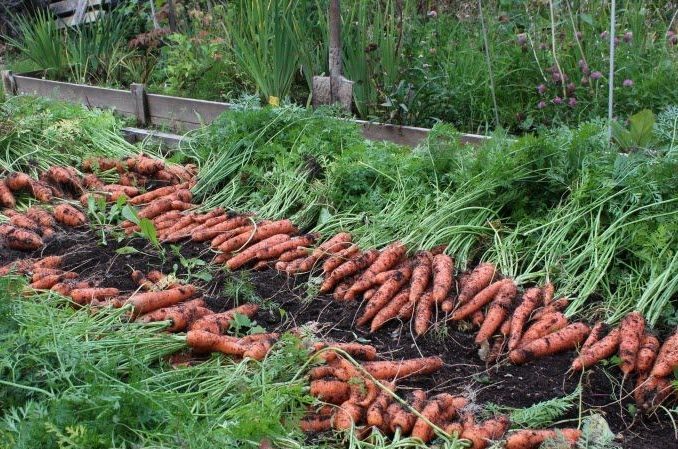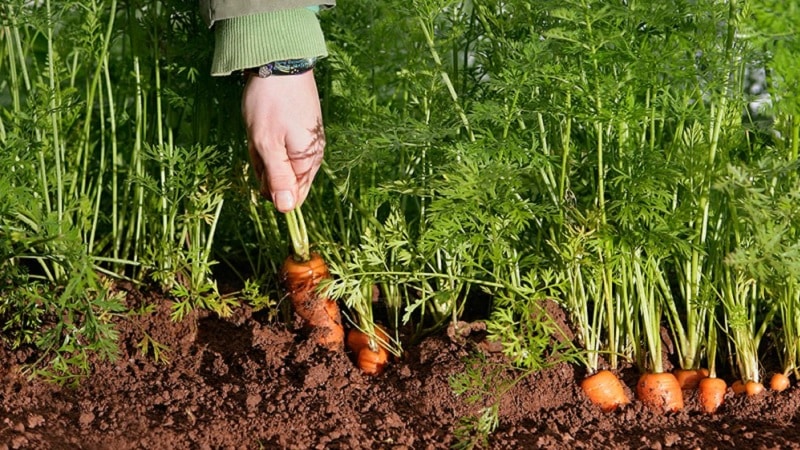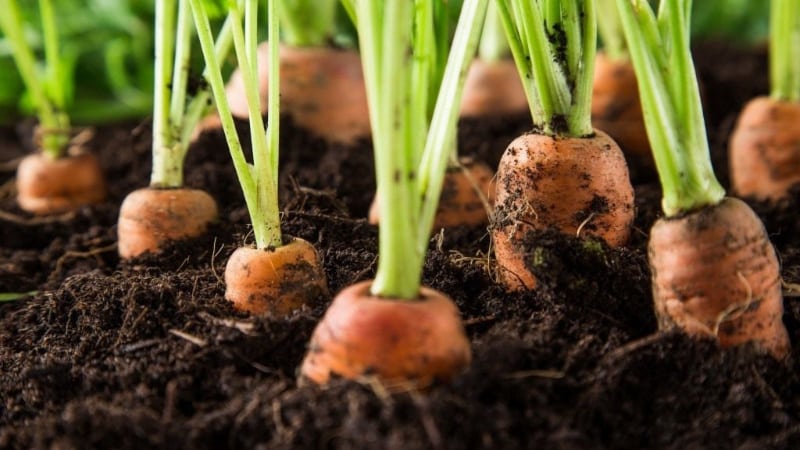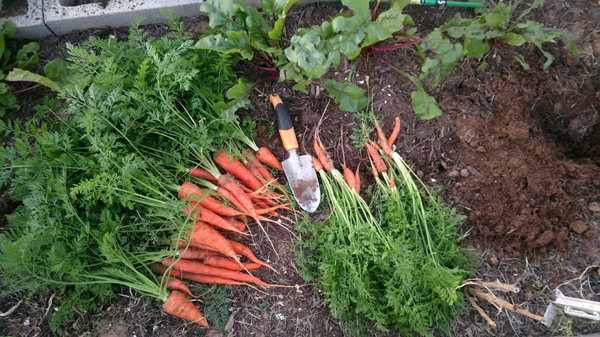Optimal timing for harvesting carrots in the Urals
Sowing carrot seeds and growing a decent harvest is only half the battle. The main thing is to remove it from the garden in a timely manner so that during further storage it does not lose quality until spring. It is impossible to give specific terms for cleaning, since they depend on many factors. One of them is the peculiarities of climatic conditions in different regions of Russia. When to harvest carrots in the Urals, read on.
Optimal harvesting times in the Urals

Carrots are a very popular vegetable in Russia and are grown everywhere. It is well stored in the cellar, but only under certain conditions and proper collection.
If you dig up root crops prematurely, they will quickly lose their juiciness, become flabby and dry, and if harvested too late, they will begin to sprout and lose their taste.
Attention! Unripe and frost-damaged vegetables cannot be stored for long periods of time.
At the end of August - beginning of September, carrots are still actively growing. The yield increase during this period is 40-45%. Therefore, haste will lead to a shortage of vegetables and small root crops.
In the Urals, the most favorable period for harvesting carrots is considered to be mid-late September. It is during these periods that it is possible to obtain the highest harvest, which will last all winter.
Depending on the variety
The Ural region is characterized by a continental climate. Cold winters with severe frosts are replaced by short but hot summers. In spring and autumn, air temperatures are also quite variable.Therefore, carrot varieties that are most suitable for such differences are selected for planting.
The short summer in the region suggests growing carrots with early and medium ripening periods (in open ground), so that the root crops have time to fully ripen before the first frost.
So, when planting a mid-season variety in mid-May, by the end of August the gardener is already inspecting the carrots for readiness for harvesting. Late-ripening varieties are often sown in greenhouses and greenhouses.
Harvesting time for early varieties

For growing early-ripening carrots in the Urals, special zoned varieties and hybrids have been bred, which not only produce stable yields, but are also suitable for long-term storage.
These include Amsterdam, Nastena, Dragon, etc. They ripen within 70-90 days after germination. Harvesting of early ripening varieties begins in mid-August. These carrots have a less intense taste. It can be consumed both fresh and after processing.
Mid-early
Mid-season carrot varieties (Vitamin 6, Altai shortened, Red giant, Forto) are harvested in late August - early September. The ripening period is 90-120 days from the moment the first shoots appear.
Late ripening
Late varieties and carrot hybrids are intended for long-term storage. They retain freshness and pleasant taste for a long time. Ripen within 120-130 days. Harvesting takes place from the beginning to the end of September.
Depending on the weather

The timing of harvesting root crops is highly dependent on the weather. It can be warm until October even in the northern regions or cold already at the beginning of autumn in central Russia.
Experienced gardeners believe that carrots should be dug up for storage after the first slight frost, then the crop will be better stored in winter. This is partly true. Carrots are cold-resistant plants, and it is during cold weather that an intensive outflow of nutrients from the tops into the root crops begins.
If prolonged frosts are expected, and the carrots have not yet been harvested, carefully bend the tops and cover the beds with agrofibre.
The timing of harvest also depends on what kind of summer it was:
- If the weather is dry and hot, carrots ripen faster. In this case, it is dug up earlier.
- Cold summers with prolonged rains delay the ripening of root crops, which means the harvest time will be delayed by several days or even weeks.
In warm weather (from +18°C), experts do not recommend holding the event due to condensation that occurs when heated carrots are lowered into a cold cellar. Increased room humidity will cause rotting of carrots during storage.
A dry, cloudy and cool day is chosen for harvesting. It is advisable that there is no rain a few days before the work. Then the carrots will dry quickly and will be stored for a long time.
If cold, damp weather is forecast at harvest time, the carrots will freeze and rot instead of growing. In this case, it is better to start harvesting a little earlier. In addition, such weather conditions contribute to the infection of the crop with gray rot.
You should not collect vegetables in rainy and damp weather or immediately after rain. Root crops become too saturated with moisture, which reduces their shelf life or simply cracks.
According to the lunar calendar
To determine the harvest date, the lunar calendar is used, having previously determined the degree of maturity of the vegetable. The moon influences the flow of sap in plant cells; during the waning phase of the celestial body, circulation slows down. It is during this period that it is recommended to start harvesting.
According to the lunar calendar, the most favorable days in 2020 will be those on which the Moon will be in the constellations of Aries, Leo, Capricorn, Taurus and Gemini.
Carrot harvesting dates this year:
- August – 8-14, 28-29;
- September – 4-10, 24-25.
During intermediate periods (during a full moon, new moon or eclipse), it is undesirable to carry out any gardening work.
Signs that the crop is ready for harvest

In addition to the carrot variety, it is important to consider the appearance of the plants during harvesting. The readiness of root crops is determined by the following signs:
- The lower and middle leaves have turned yellow. If the date corresponds to the time of harvesting and weather conditions permit, the carrots are removed from the garden without waiting for the top leaves to turn yellow. If all the tops turn yellow at the same time, this means that the carrots have been affected by the disease.
- Compliance with the size of the carrots, which is written on the package with seeds. To check, pull out one root crop and study it. When the sizes correspond to the varietal characteristics, harvesting begins.
- The presence of thin white roots on root crops.
If cracks are found on several root crops when checking maturity, the entire crop is immediately harvested. Otherwise, the carrots will begin to outgrow.
How to properly dig carrots from the garden for storage

To properly dig carrots from the garden, follow these recommendations:
- During collection, it is recommended to use garden tools. Forks are best suited for this.
- When the soil on the site is light and sandy, and the carrot variety is short-fruited, the crop is usually harvested by hand, pulling the tops. In other cases, use a tool, because the tops will break off.
- The crop is harvested in the following way: the carrots are dug up with a pitchfork, after which they are taken by the tops and taken out of the ground. When digging, make sure that the distance from the forks to the root crops is approximately 15 cm.
- To speed up the collection, it is recommended to do the collection together. One person digs up, and the second immediately pulls out the carrots by the tops.
- When harvesting, act as carefully as possible so as not to damage the root crops. This is especially true at the moment of digging. Damaged ones will not last long.
Methods for removing tops
Carrot tops removed immediately after digging. If leaves are left, they will continue to evaporate moisture, causing the crop to quickly wilt.

Basic methods for removing tops from carrots:
- Twisting. Some gardeners are sure that this method increases the shelf life of root crops.
- Using scissors or a sharp knife. This is the most common method and is suitable for short-term storage. If you store such a crop until spring, new greenery will begin to grow from the petioles.
- Removing the tops along with the top part of the carrots. This place is called the growth point. This way the crop will not germinate until next spring.
The last method is usually chosen only by those gardeners who already have extensive experience in this matter. The method requires maximum cutting accuracy. After removing the tops, the root vegetables are dried.
Preparation for storage
When preparing the harvest for storage remove the tops. After this, the vegetables are laid out on the beds to dry.But if rain is expected, the carrots are removed indoors. Dry for several hours.

The carrots are sorted and the following root vegetables are separated from the total mass:
- broken;
- with cracks;
- damaged by insects or rodents;
- affected by disease;
- with damaged skin.
The carrot harvest cannot be sent to a common storage with other vegetables. This way the root vegetables will quickly spoil and harm other products. Infection with various diseases occurs very quickly, especially for fungal spores.
Most suitable storage conditions:
- humidity – 90-95%;
- temperature – from 0 to +1°C.
Even small deviations from recommended storage conditions significantly reduce the shelf life of the product.
The process includes the following steps:
- After preliminary drying in the garden bed and sorting, the crop is laid out on fabric or film under a canopy. Dry for 2-3 days to remove excess moisture from the surface of the vegetables.
- Carrots are placed in baskets or boxes with holes and sent to a cool, dark place. Within a week it will go into the resting stage. This procedure is required to prevent vegetables from sprouting.
- The harvest is stored in the cellar. Preferably in boxes with sand, which is pre-calcined and 100 g of lime is added to each bucket. A small layer is poured onto the bottom of the boxes and the root vegetables are laid out so that they do not touch each other. They are covered with sand on top and the next layer is laid out.
Conclusion
To correctly determine the harvest time for carrots in the Urals, the climatic features of the region and the variety of the vegetable are taken into account. They also pay attention to external signs of readiness, for example, yellowing of the tops and the size of the root crops.
It is important to properly prepare the harvested crop for storage: sort through and discard damaged carrots, remove the tops and dry the root vegetables.